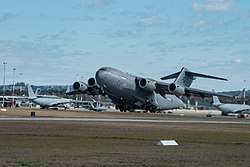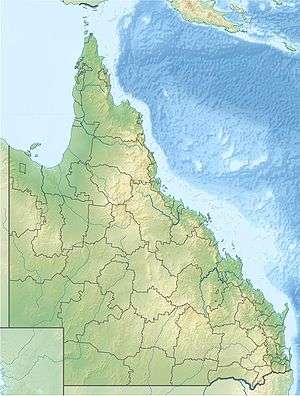RAAF Base Amberley
RAAF Base Amberley (ICAO: YAMB) is a Royal Australian Air Force (RAAF) military airbase located 8 km (5.0 mi) southwest of Ipswich, Queensland in Australia and 50 km (31 mi) southwest of Brisbane. It is currently home to No. 1 Squadron and No. 6 Squadron (operating the F/A-18F Super Hornet), No. 33 Squadron (taking delivery of the Airbus KC-30A) and No. 36 Squadron (operating the Boeing C-17 Globemaster III jet transport). Amberley is also home to Army units making up the 9th Force Support Battalion (9 FSB). Located on 1,600 hectares (4,000 acres), RAAF Amberley is the largest operational base in the RAAF, employing over 5,000 uniformed and civilian personnel.[2] There are a variety of other formations on the base such as training colleges and maintenance areas. Amberley's largest squadron in terms of personnel is No. 382 Expeditionary Combat Support Squadron RAAF (ECSS) providing both garrison and deployed combat support. Amberley was one of only two airfields in Australia (the other being Darwin International Airport) that were listed as a Transoceanic Abort (TOA) landing site for the Space Shuttle.[3] Amberley is currently undergoing a A$64 million dollar re-development program. The RAAF has plans to have Amberley operating as its "superbase" with flights of F/A-18F Super Hornets, F-35 Lightning II, KC-30A, C-17 Globemaster. No. 35 Squadron (operating C-27J Spartan) is planned to move to the base from RAAF Base Richmond after it is fully equipped with the C-27J.
| RAAF Base Amberley | |||||||||
|---|---|---|---|---|---|---|---|---|---|
| Ipswich, Queensland in Australia | |||||||||
 A RAAF C-17 Globemaster III taking off from RAAF Base Amberley, with KC-30 and F/A-18F aircraft in the background | |||||||||
 RAAF Base Amberley YAMB Location in Queensland | |||||||||
| Coordinates | 27°38′26″S 152°42′43″E | ||||||||
| Type | Military airbase | ||||||||
| Area | 1,600 hectares (4,000 acres) | ||||||||
| Site information | |||||||||
| Owner | Department of Defence | ||||||||
| Operator | |||||||||
| Site history | |||||||||
| Built | June 1940 | ||||||||
| In use | June 1940 – present | ||||||||
| Garrison information | |||||||||
| Occupants | |||||||||
| Airfield information | |||||||||
| Identifiers | ICAO: YAMB | ||||||||
| Elevation | 28 metres (91 ft) AMSL | ||||||||
| |||||||||
| Sources: Australian AIP and aerodrome chart[1] | |||||||||
History
The need for a RAAF base in Brisbane was identified in the 1930s. 882 acres (357 ha) of land near Ipswich was gazetted for defence purposes on 12 December 1938. The base was initially planned to house a general purpose squadron with 300 officers and men. At the outbreak of World War II the handful of brick buildings were still incomplete and many extra buildings were constructed quickly using wood and fibro. The base opened in June 1940 with the first unit based there being No. 24 Squadron. From May 1942 the base changed roles from flying operations to mainly assembly and repair of aircraft.
United States Army Air Force base
The base was a major United States Army Air Forces base during 1942 and 1943. Known Fifth Air Force units assigned to "Amberley Field" were:
| Unit | Aircraft | Assigned | Reassigned | Time at Amberley | Notes |
|---|---|---|---|---|---|
| 22d Bombardment Group | B-26 Marauder | 7 March 1942 | 7 April 1942 | 31 days | |
| 38th Bombardment Group, Headquarters | B-25 Mitchell | 30 April 1942 | 10 June 1942 | 41 days | |
| 69th Bombardment Squadron | B-26 Marauder | 20 May 1942 | 20 days | ||
| 70th Bombardment Squadron | 11 May 1942 | 14 August 1943 | 1 year, 95 days | ||
| 475th Fighter Group, Headquarters | P-38 Lightning | 14 May 1942 | 1 year, 92 days | ||
| 431st Fighter Squadron | 1 July 1943 | 44 days | |||
| 432d Fighter Squadron | 11 June 1943 | 64 days | |||
| 433d Fighter Squadron | 17 June 1943 | 58 days |
The US facilities were transferred to Australia in 1947.[4] After the war it became the base for the RAAF's heavy bombers operated by No. 1, No. 2 and No. 6 squadrons. The reserve No. 23 (City of Brisbane) Squadron relocated from RAAF Station Archerfield to Amberley in 1955.
In 1965, the US extended a "Joint Research Program for Measuring the Physical Effects of Disturbances in the Atmosphere or in Space with particular emphasis on their effect on Radio Communications" from RAAF Base Pearce to the base at Amberley.[5]
Current units
The following units are based at RAAF Base Amberley:[6][7][8]
| Royal Australian Air Force | ||||
|---|---|---|---|---|
| Unit | Full name | Force Element Group | Aircraft | Notes |
| HQ82WG | Headquarters No. 82 Wing | Air Combat Group | ||
| 1SQN | No. 1 Squadron | Air Combat Group | F/A-18F | |
| 6SQN | No. 6 Squadron | Air Combat Group | EA-18G | |
| 278SQN DET AMB | No. 278 Squadron Detachment Amberley | Air Combat Group | ||
| 33SQN | No. 33 Squadron | Air Mobility Group | KC-30A | |
| 36SQN | No. 36 Squadron | Air Mobility Group | C-17 Globemaster III | |
| 452SQN AMB FLT | No. 452 Squadron Amberley Flight | Surveillance and Response Group | ||
| HQCSG | Headquarters Combat Support Group | Combat Support Group | ||
| HQ 95WG | Headquarters No. 95 Wing | Combat Support Group | ||
| 382SQN | No. 382 Squadron (Contingency Response Squadron) | Combat Support Group | ||
| 295SQN | No 295 Squadron (Training and Standards) | Combat Support Group | ||
| 1CCS DET AMB | No. 1 Combat Communications Squadron Detachment Amberley | Combat Support Group | ||
| 2 SECFOR | Headquarters No. 2 Security Forces Squadron | Combat Support Group | ||
| HQ 96WG | Headquarters No. 96 Wing | Combat Support Group | ||
| 23SQN | No. 23 (City of Brisbane) Squadron | Combat Support Group | ||
| HQHSW | Headquarters Health Services Wing | Combat Support Group | ||
| 1EHS | Headquarters No. 1 Expeditionary Health Squadron | Combat Support Group | ||
| 3AMES DET AMB | No 3 Aero-medical Evacuation Squadron Detachment Amberley | Combat Support Group | ||
| HOCU | Health Operational Conversion Unit | Combat Support Group | ||
| RAAFSFS | RAAF Security and Fire School | Air Force Training Group | ||
| HALSPO | Heavy Air Lift Systems Program Office | Defence Materiel Organisation | ||
| SRSPO | Strike Reconnaissance Systems Program Office | Defence Materiel Organisation | ||
| ARDU | Aircraft Research and Development Unit Detachment Amberley | Aerospace Operational Support Group | ||
| Australian Army | ||||
| 6 ESR | 6th Engineer Support Regiment (except 20 EOD Sqn) | 6th Brigade | ||
| 9 FSB | 9th Force Support Battalion (except 176 AD Sqn) | 17th Sustainment Brigade | ||
See also
References
![]()
- YAMB – Amberley (PDF). AIP En Route Supplement from Airservices Australia, effective 21 May 2020, Aeronautical Chart
- "RAAF Base Amberley" (PDF). Department of Defence. Australian Government. 1 October 2013. Retrieved 14 August 2017.
- Pike, John. "Space Shuttle Emergency Landing Sites". www.globalsecurity.org.
- "Agreement between the Government of Australia and the Government of the United States of America concerning Aerodrome Facilities. ATS 4 of 1947."". Australian Treaty Series. Australasian Legal Information Institute. Retrieved 15 April 2017.
- "Exchange of Notes constituting an Agreement between the Government of Australia and the Government of the United States of America regarding a Joint Research Program for Measuring the Physical Effects of Disturbances in the Atmosphere or in Space with particular emphasis on their effect on Radio Communications. ATS 4 of 1965". Australian Treaties Library. Australasian Legal Information Institute. Retrieved 15 April 2017.
- Nelson, Laraine; McAuley, Joanne (2019). The heritage values of RAAF Base Amberley : from Hornet Moth to Super Hornet (PDF). Canberra: Defence Publishing. ISBN 9781925890051. Retrieved 11 January 2020.
- Department of Defence (March 2015). 17th Construction Squadron Relocation Infrastructure Project - RAAF Base Amberley, Queensland - Statement of Evidence (Report). Retrieved 12 January 2020.
- "RAAF Base Amberley". Royal Australian Air Force. Retrieved 12 January 2020.
Further reading
- Maurer, Maurer (1983). Air Force Combat Units of World War II. Maxwell AFB, Alabama: Office of Air Force History. ISBN 0-89201-092-4.
- Maurer, Maurer, ed. (1982) [1969]. Combat Squadrons of the Air Force, World War II (PDF) (reprint ed.). Washington, DC: Office of Air Force History. ISBN 0-405-12194-6. LCCN 70605402. OCLC 72556.
External links
![]()